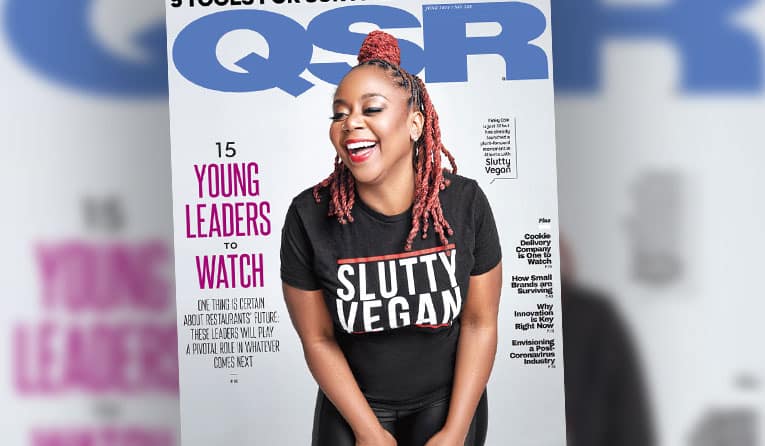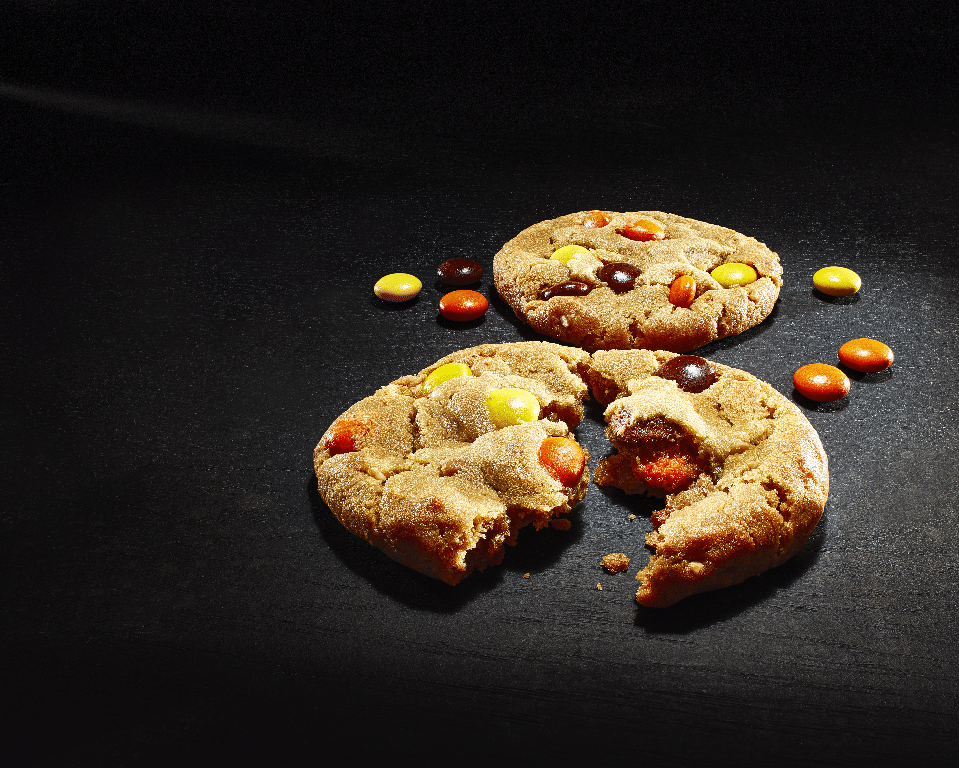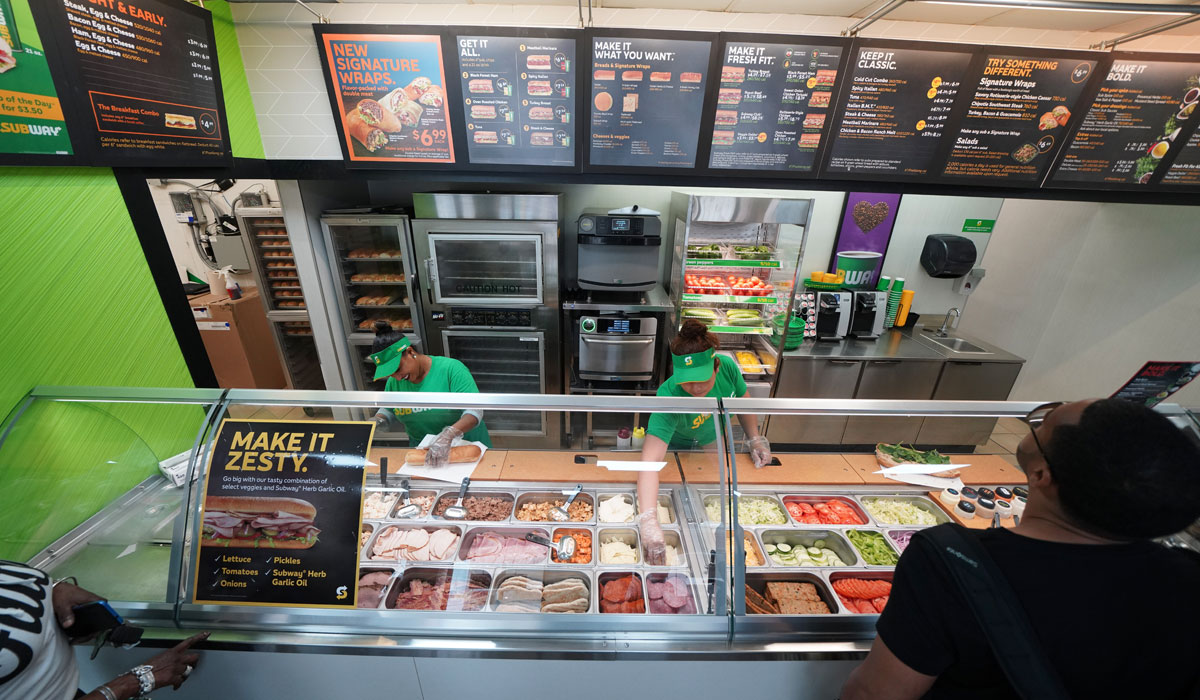John Chidsey had a comfortable seat on the sidelines. The former Burger King chairman and lead executive was content to offer advice on boards, invest, and generally not consider the idea of directing another major restaurant chain.
It had been eight full years since he stepped down at the burger giant a year or so after its 2010 sale to 3G Capital.
Yet if there’s one figure in this business that can reawaken somebody’s attention, it’s this: Some 95 percent of Americans live within a 10-minute drive of a Subway.
And yet the ubiquitous nature of the world’s largest restaurant chain wasn’t indicative of an opportunity that had run its course.
Like Burger King, labeled by some a floundering chain before Chidsey took over in 2006 and engineered a turnaround, Subway was trudging in neutral. The 56-year-old company, private its entire life, didn’t operate with any real sense of urgency, Chidsey says.
Just weeks after Subway’s 50th anniversary in September 2015, co-founder Fred DeLuca, who started the brand when he was 17 in 1965, passed away. DeLuca, 67, battled leukemia since 2013.
Chidsey says Subway lost its way a bit. Perhaps not stuck in a malaise, exactly, but it lacked direction. Subway needed to figure out who it wanted to be in its next act.
And Chidsey thought he might have an idea.
He officially joined in fall 2019 and got to work. Of the top 100 employees in Subway’s leadership team, some 75 percent are new hires. They hail from Burger King parent Restaurant Brands International; Dunkin’; Yum! Brands; Outback owner Bloomin’. “All people we knew,” Chidsey says. “We hardly used head hunters.”
It didn’t take long for Chidsey to lock in on Subway’s greatest differentiator and perhaps also its greatest challenge. Subway ended 2020 with 22,201 domestic locations. That’s 1,612 fewer than the previous year, and the continuation of a sloping trend. There were 23,802 stores headed into 2020 and 24,798 locations by year-end 2018. Subway boasted 27,103 U.S. restaurants at the close of 2015.
READ MORE: Where Subway ranks on this year’s QSR 50, by sales, AUV, and more
Before an 866-store decline from 2016–2017, Subway added 4,456 restaurants the previous six years combined. And it was steady growth to a measure few companies in retail history could rival: 816, 872, 956, 878, 778, and 145. The 2015 count was more than Burger King, Wendy’s, Taco Bell, and Pizza Hut combined. It was 12,844 more than McDonald’s and 14,582 ahead of Starbucks.
As Chidsey explains, though, it was clear Subway morphed into a development-focused restaurant company. His goal? Evolve it into an “experience-focused organization.”
“What we would all consider more of a traditional restaurant company,” he says. “And that’s a multi-year journey.”
Work toward the change didn’t quite begin on day one, Chidsey adds, but it wasn’t long after. Research was ready for review when he showed up. Chidsey doubled or tripled the effort, he says, and then Subway conducted more.
Call-outs from the brand’s analytics and insights teams sketched a clear roadmap. Subway needed to widen its lens and compete not just against other fast-food giants with scale—the McDonald’s, Wendy’s, and Burger Kings of the world—but also against emerging sandwich brands. That blip on Subway’s radar had become a flashing siren.
At the end of 2015, there were 1,046 Jersey Mike’s in America. Firehouse Subs had 945 stores. Jimmy John’s 2,405. If you added those together they represented just 16 percent of Subway’s U.S. footprint.
Accelerate to 2021 and Jersey Mike’s has 1,856 locations. Firehouse 1,140. And Jimmy John’s 2,705.
Beyond just a numbers game, however, it’s really consumer perception that’s caught up to Subway. It’s hardly the only sub restaurant in town anymore and that includes a bevy of fast casuals. It’s also likely not the lone quick-serve promoting itself as a healthier alternative to the “big guys.”
Subway’s consumer data was “overwhelming,” Chidsey says, to these points and what needed to change. More craveable options. More innovation. A quality-forward ethos that centers on the core.
Subway’s answer is coming in stages (in a system this large you can’t do everything at once, Chidsey says), and 1.0 splashed in mid-July.
The company rolled more than 20 significant menu updates across its U.S. system—what it calls the “Eat Fresh Refresh.” Based on records they could find, Chidsey says, this was the most extensive overhaul in brand history.
Unlike some past efforts, though, Subway built everything from the core out. It introduced 11 new and improved ingredients, six all-new or returning sandwiches, and four revamped signature options. A highlight being two new fresh-baked breads, Artisan Italian and Hearty Multigrain.


Beginning July 13, guests noticed fresh sauces, breads, and proteins. Among them: new deli-thin sliced ham and turkey, hickory-smoked bacon, smashed avocado, BelGioioso Fresh Mozzarella, and a tangy MVP Parmesan Vinaigrette.
Additionally, Subway debuted chef-recommended sandwiches such as the Turkey Cali Fresh, Steak Cali Fresh, and All-American Club.
Subway also completely redesigned its digital ordering experience and app to “provide the same customized and consistent experience found in Subway restaurants.” The updated platform features a new dashboard, improved ordering flow, and insight into out-of-stock items with further updates planned for the fall. In-store pickup and contactless curbside (a COVID measure) are now readily accessible. Subway developed a direct delivery feature to provide guests with the same pricing as in-store ordering and generate profitable growth for franchisees, the company said.
Subway devised fresh in-store merchandising and packaging and ignited its largest campaign ever that “brings our iconic brand and unique voice to life.” TV, uniforms, an “all-inclusive push for the guest to realize there’s a lot different about the brand, and a lot that you should come experience,” Chidsey says.
It was such a monumental effort Subway closed more than 10,000 locations across the country at 6 p.m. on July 12 so employees could get ready. When they opened the following day, Subway gave away up to a million free subs from 10 a.m. to noon.
As noted, Chidsey says Subway received a wake-up call from its competition. And so it had to ask itself, perhaps for the first time, “how do we get there?”
It wasn’t about chasing the next great sandwich, Chidsey says. It was finding Subway’s DNA and giving it an injection.
Now, when Subway reintroduces classics, it won’t just aim to tug on nostalgic consumers; it hopes to surprise them, too. The Chicken Bacon Ranch, for instance, is going to feature bacon Subway customers haven’t tried before.
“I think there’s going to be more than enough to have guests realize, ‘wow, something is really different at Subway,’” Chidsey says. “And they have invested heavily behind food innovation.”
Over the next 12–24 months, he adds, guests are going to constantly see improvements.
Yet Subway’s refresh isn’t solely a consumer-facing narrative. Reinvigorating the chain’s franchise base and getting operators enthused again is as critical as any marketing push. If not more so.
“In a way, it’s as much about a rallying cry for them as it is showing the consumer there’s something new and different,” Chidsey says.
When Chidsey interviewed for the job, Subway informed him there were more than 10,000 domestic franchisees in the system. “I thought, that’s impossible,” he says. “That’s more restaurants than Burger King has in the U.S.”
Simply, it’s a lot of people to motivate. COVID-19 didn’t help matters. “My joke is, every day you spend in a corporate headquarters is a wasted day because you learn so much more being out in the field with your operators,” Chidsey says. “On the frontlines. What you’re doing right. What you’re doing wrong.”
Before his stint at Burger King, Chidsey served as chairman and CEO for two corporate divisions of Cendant Corporation. He led the vehicle services side, which included Avis Rent A Car, Budget Rent A Car Systems, PHH and Wright Express, and the financial service group that featured Jackson Hewitt Tax Preparation Services and various membership and insurance companies. He also held international leadership roles with PepsiCo. “I’ve just been franchising my whole life,” Chidsey says.
While Chidsey admits there’s been friction at times with operators over the past year, the “vast, vast majority” are excited about Subway’s trajectory and shift from a development mindset to an experience-forward one. From maniacal growth to competitive awareness and response.
But don’t let superlatives tell the story. Chidsey says Subway’s results from January to April back a tale that’s easy to get behind.
“This place needed hope. Optimism. I think now they’ve got it,” CEO John Chidsey says.
Again, Subway is not your average restaurant chain when it comes to sheer size. As of May, Subway’s bottom quartile performers—stores in colleges or empty office parks or downtown locations—remained down 30–40 percent from pre-COVID levels.
The top three quartiles, however, posted positive gains. Not just against 2020 pandemic holes, either, but versus 2019.
How sizable is Subway’s top three quartiles? It’s a collection larger than McDonald’s.
January through April, the top half of Subway’s restaurants were up over 10 percent, Chidsey says. That group is bigger than Burger King or Taco Bell.
“So to be up double-digits for half your system over 2019, and to be positive for the top three quartiles, franchisees are noticing,” Chidsey says.
Subway’s top quartile’s sales comped a smidge under 20 percent, he adds. That’s more restaurants than KFC.
“If you look at it numerically, clearly, we’re going in the right direction despite whatever you read in the press,” Chidsey says.
Subway’s leadership traveled to Dallas recently to meet with 300–400 franchisees. Chidsey says he asked each room, “who has all-time best, highest sales?” in recent periods.
“And I would say it was a good 50 percent,” he says. “Sometimes 75 percent.”
“If we can continue that, as you know in this industry, sales cure cancer,” he adds. “If we can keep that track record going, I think we’ll be in a great spot.”
While COVID made it difficult for Chidsey to interact face-to-face with franchisees out of the gate, he says being rooted to HQ in Milford, Connecticut, “allowed us to turn over the rocks much faster.”
Subway quadrupled digital sales in 2020. A lot of that came from in-app improvements and attention to friction points. Subway rebuilt third-party delivery relationships. To the overall refresh, it worked on direct delivery where the aggregator takes care of the last mile.
Subway officially launched curbside to more than 11,000 restaurants in November, which was a massive undertaking. The brand onboarded up to 1,800 restaurants per week. Early on, operators reported roughly 50 percent higher ticket sales versus dine-in, and ordering during off-peak hours surged, not unlike a drive-thru. You saw this unfold with targeted marketing, including NFL legend Deion Sanders conducting some orders himself.
This was essential, Chidsey says, to compete with McDonald’s, Wendy’s, Burger King, et al during the COVID clamp down. Subway only boasts about 1,000 drive-thrus out of its 20,000-plus venues.
Subway dove deep, including food photography, which improved exponentially, Chidsey says. Advertising is crisper. “When I looked at the reels, it’s been quite a while since I think they were in the cultural zeitgeist and relevant,” Chidsey says. “I can’t point to any one thing and go that’s it. But I think it was a lot of singles that added up to a lot of things.”

Chasing opportunity
It’s likely Subway will continue to retract domestically over the near-term. The message Chidsey tries to get across is the company would rather have five, nice looking remodels and high-performers than seven stagnant units. “Because my bet is you’re going to get more sales out of those five than you would out of seven,” he says.
In the past, Subway was all about its development dartboard. Chidsey wants to take more of a portfolio approach with franchisees and figure out what’s the right size, he says, and get away from being so restaurant-count centric.
One avenue of whitespace, though, will come with non-traditional. Chidsey says he’s learned to appreciate Subway’s agility, which is part of the reason it scaled so quickly and so vastly in the first place.
You can fit them almost anywhere. No fryer. No broiler. No hood. No grease trap. Comparatively speaking in the industry, it’s a much simpler operation with plenty of flexibility.
Chidsey says Subway is working on grab-and-go-units. Vending units. Kiosks.
Consider an airport, he says. If there’s terminal A, B, C, and D, Subway can open a store in the most populous spot. But it could then easily add a kiosk in one or more of the other terminals.
In fact, Subway is testing this model in Cincinnati. One restaurant feeds the other. The main restaurant puts, say, 50 prewrapped sandwiches in the grab-and-go. Customers can get drinks and chips.
Subway can also go to places like Love’s Travel Stops or Pilot Flying J sites. There’s a restaurant in the truck stop that’s open 15 hours a day. The brand devised grab-and-go units that employees load up before they leave the restaurant. And customers can purchase sandwiches throughout the night.
“So you’re really leveraging your existing kitchen and finding ways to build,” Chidsey says. “… It’s almost like a hub-and-spoke. You’ve got the restaurant in the middle. Think of an Army base. Think of a college campus. And you can have all these, what I call ‘asset-light models’ out there that feed off that core kitchen.”
“Clearly, that’s an opportunity.”
Another, and this one Chidsey calls, “the largest growth opportunity in this brand by a mile,” comes via international runway. Of the six global players with true scale in Chidsey’s view—McDonald’s, Burger King, KFC, Domino’s, Starbucks, and Subway—only Subway is larger in the U.S. than outside the country.
“You don’t even need to get remotely near the penetration we have in the U.S. and you could easily have 30, 40, 50,000 restaurants outside the U.S.,” Chidsey says.
Presently, Subway has somewhere in the neighborhood of 13,000–14,000 international stores.
Why hasn’t it grown larger overseas? Chidsey says there was a previous approach where Subway had development people in countries. Unlike Burger King or Domino’s, which go find an institutional investor developer that says, “I’m signing a deal to build you 800 Burger Kings in the country.”
“So we’ve ripped that up and we’ve said, we’re going to go with the traditional [quick-service restaurant] model and go find people who have already built a lot of units for some other brands, or just people we think have the experience and the wherewithal,” Chidsey says.
In the next six to 24 months, Chidsey says, people could expect “lots of deals” to be signed where parties commit to “multi-hundred [restaurants].”
“And so, I think we can totally transform the international landscape for Subway,” he says.
Subway is doing well internationally, he explains, but “we can blow the doors off and make it three, four times bigger than it is.”
Consolidation is something to circle as well. Previously, Subway courted a smaller franchisee model. But Chidsey says he’s comfortable if operators want to go in and buy up “lots of their smaller colleagues.”
“I’m all for that,” he says.
The situation overall at Subway isn’t all that dissimilar to the one Chidsey walked into at Burger King, which came off six straight down years of sales.
“This place needed hope. Optimism. I think now they’ve got it,” he says. “I want [franchisees] to feel good enough about the future that they will invest in remodels. That they will buy new equipment if they need new ovens, if they need new fountain equipment. Whatever it is. That they’re confident enough that they’re going to invest in the business.”
“And then those that want to grow feel confident that they can get from eight Subways to 12, from 12 to 20,” Chidsey continues. “Or the person who has 20, they want 40. I think it’s just that confidence and belief in the brand that will allow them to stop looking in the rearview, because you can’t fix what’s in the rearview mirror, you can only fix what’s in front of you.”









